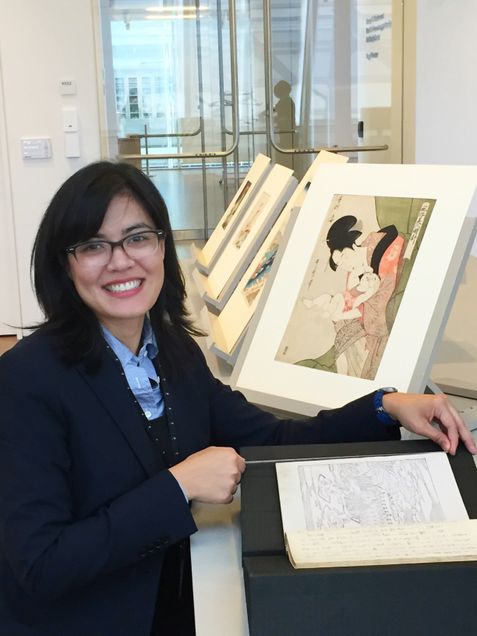Quintana Heathman Scherer
CAS, 2005
GRS, 2006
1) What have you been doing since you graduated from BU? Details about your current and past employment? Accomplishments you’re proud of? Challenges you’ve encountered?
When I graduated with my MA from BU almost fifteen years ago I had no idea where my career would lead, but I knew I was interested in curatorial work. As a specialist in Japanese art, I have had wonderful opportunities to develop my research and curatorial skills by working at the Museum of Fine Arts, Boston, the RISD Museum, the Philadelphia Museum of Art, and the Harvard Art Museums. At these institutions I gained invaluable experience working firsthand with artworks through varied roles, including a research assistant on a massive Japanese print cataloguing project, an exhibitions assistant on a major international loan exhibition, and developing my own exhibitions of Japanese art. I previously co-curated “A Sense of Place: Modern Japanese Prints” at the Arthur Ross Gallery, University of Pennsylvania, and “Luxury on Paper: The Art of Surimono” and “Visions of Kyoto: Scenes from Japan’s Ancient Capital” both at the Museum of Fine Arts, Boston. Most recently I curated “Japan on Paper” at the Harvard Art Museums (https://harvardartmuseums.org/exhibitions/5803/japan-on-paper).
I also continued my academic career, studying at Gakushūin University in Tokyo as a Monbukagakushō scholar and then completing my PhD in art history at the University of Pennsylvania.
After working as a curatorial assistant at the Manetti Shrem Museum of Art at UC Davis, where I expanded my knowledge of contemporary printmaking and curated “Working Proof: Wayne Thiebaud as Printmaker” (https://manettishremmuseum.ucdavis.edu/working-proof), I transitioned to a new position in fall 2021 and returned to academia as an assistant professor of Japanese art history at Kanagawa University in Yokohama, Japan. Teaching art history as part of a new department of Japanese and Cross-Cultural Studies is an exciting opportunity to help students understand how art shapes and informs international exchange throughout history.
2) How your time in the department shaped your professional and personal lives?
As someone who completed both a BA and MA in art history at BU the department has been instrumental in setting me upon my current path. When I arrived at BU as an undergraduate I didn’t even know what “art history” was! It was only after taking my first course (I think it was a decorative arts course with Professor Hall) that I began to understand how studying art history could help me understand our visual world. From then I knew what I wanted to study and endeavored to find ways to make the study of art history into a career. I am thankful to the fantastic faculty BU who introduced me to this amazing field during my undergraduate years.
As a graduate student I was fortunate to have intelligent, dedicated, and generous mentors in Professors Bai and Tseng, who guided me as I studied the breadth of Asian art history and developed my specialization in Edo period Japanese art. Professor Bai was generous with his time, and I will never forget the visits he arranged to important collections. Professor Tseng’s mentorship was vital as I began to find my footing as a scholar and refine my interests in the field; she taught me how to look at Japanese art history (and my own understanding of it!) with a critical and analytical eye.
In my personal life, being at BU gave me a wonderful network of friends and colleagues, and allowed me to be immersed in the rich and vibrant city of Boston. I met so many amazing people in the city, and even met my future partner out on the waters of the Charles River. Be sure to go out on the river!
3) Any advice that you would’ve given to your younger self?
Just start writing. Start before you feel ready to write. Start before your research is done. Start even if you haven’t quite found the thesis yet. It is only through putting the words on to the paper that you truly begin to flesh out ideas and learn where the project should go. No one will see these early versions anyway, so don’t feel embarrassed if it is terrible.
Remember, it is always easier to edit bad writing than to start writing from scratch– so just sit down and write! Your future self will thank you.
